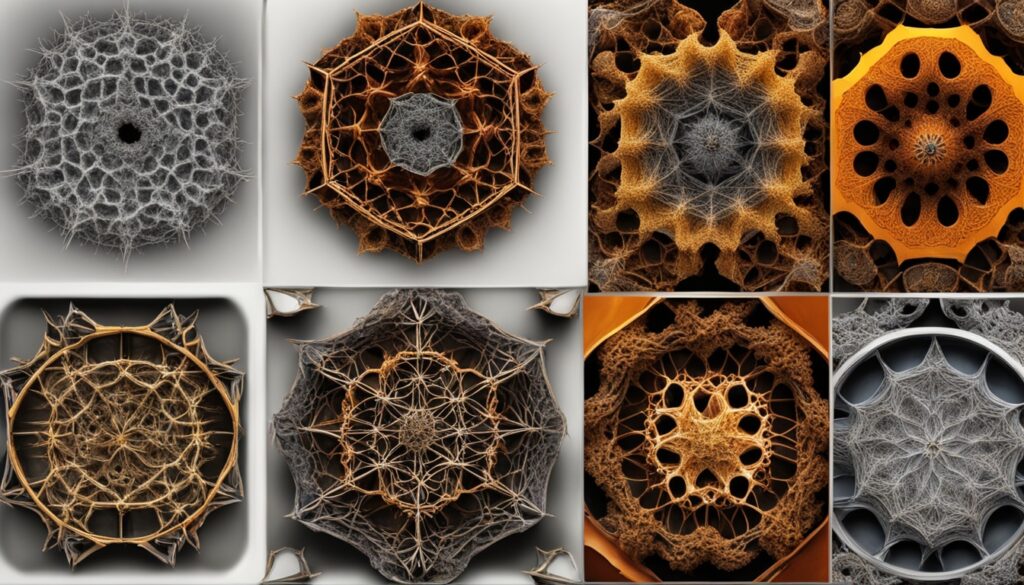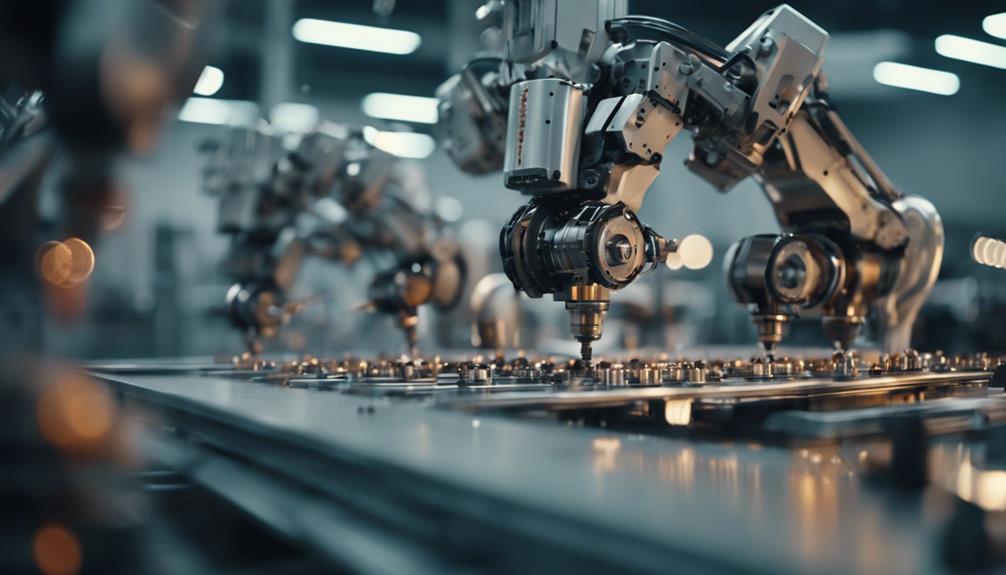You won’t believe what scientists have recently discovered in the world of chemistry. A naturally occurring molecule that forms a fractal structure has been found, and it’s truly mind-boggling. This fractal pattern, which repeats itself at smaller scales, has never before been observed at the molecular level. The molecule in question is an enzyme called citrate synthase, found in the cyanobacterium Synechococcus elongatus. When the enzyme assembles, it takes on the shape of a mesmerizing triangular fractal known as a Sierpiński triangle. This triangular structure consists of smaller triangular gaps, creating a never-ending and infinitely complex pattern. The evolutionary history of this fractal enzyme suggests that it appeared suddenly and was then lost in other bacterial versions, adding to the intrigue surrounding its discovery. While the exact purpose of the fractal shape remains unknown, this groundbreaking finding opens up a world of possibilities for further exploration and the potential existence of other complex fractal-like shapes in nature.
Key Takeaways:
- A naturally occurring molecule has been discovered that forms a fractal structure, which has never been observed at the molecular level before.
- The molecule in question is the enzyme citrate synthase found in the cyanobacterium Synechococcus elongatus.
- When the enzyme assembles, it takes on the shape of a mesmerizing triangular fractal known as a Sierpiński triangle.
- The evolutionary history of the fractal enzyme suggests that it appeared suddenly and was then lost in other bacterial versions.
- The exact purpose of the fractal shape is still unknown, but its discovery opens up possibilities for further exploration and the existence of other complex fractal-like shapes in nature.
The Evolution of the Fractal Enzyme
The fractal enzyme, citrate synthase, found in Synechococcus elongatus, has undergone a fascinating evolutionary journey. Scientists have delved into its evolutionary history by comparing its genetic sequences with those of other bacteria. Surprisingly, the fractal form of the enzyme emerged suddenly but was subsequently lost in other bacterial species, leaving it exclusively present in the cyanobacterium S. elongatus. The reasons behind this emergence and subsequent loss of the fractal shape still remain a subject of inquiry, beckoning further investigations into the prevalence of such intricate, fractal-like structures in nature and the mechanisms that govern their evolution.
Unraveling the Structure of the Fractal Enzyme
Scientists have utilized electron microscopy to gain insight into the molecular structure of the fractal enzyme, citrate synthase. Through their analyses, they have uncovered the fascinating nature of this intricate enzyme and its self-assembling properties.
The researchers discovered that the citrate synthase enzyme’s monomers, or building blocks, have the ability to assemble into a unique triangular form. This triangular structure consists of six monomers and further combines to form larger triangular shapes, resulting in the mesmerizing Sierpiński triangle fractal pattern.
What makes this fractal enzyme even more intriguing is that its molecular structure exhibits asymmetry, with different protein chains within the enzyme making slightly different interactions. This asymmetrical nature of the fractal structure adds to its complexity and challenges our understanding of protein assembly and organization.
Understanding the molecular structure of the citrate synthase enzyme sheds light on the self-assembly properties of proteins. This knowledge not only enhances our understanding of biological systems but also opens up possibilities for future applications in nanotechnology.
The Self-Assembly Process of Citrate Synthase
The self-assembly process of the citrate synthase enzyme involves the interaction of its monomers. These monomers, with their complementary shapes and properties, come together to form the triangular structures that make up the fractal enzyme.
The self-assembly capability of the fractal enzyme highlights the inherent properties of proteins, allowing them to form intricate and complex structures. This capability has immense potential in the field of nanotechnology, where scientists can harness this self-assembly process to create organized and purposeful nanostructures.
“The molecular structure of the fractal enzyme, citrate synthase, reveals the beauty and complexity of self-assembly in proteins. This discovery opens up exciting possibilities for future applications in nanotechnology.”
By unraveling the structure of the fractal enzyme, researchers have unlocked a deeper understanding of the self-assembly properties of proteins. This knowledge paves the way for the development of new materials and technologies that can exploit the unique characteristics of these fractal-like structures.
The Purpose of the Fractal Enzyme
Despite the fascinating nature of the fractal enzyme, its exact biological function and purpose are still unclear. Laboratory experiments removing the enzyme from the cyanobacterium S. elongatus did not show any obvious effects on the organism’s survival or functioning. This suggests that the presence or absence of the fractal enzyme does not significantly impact the bacterium’s biology.
However, it is possible that the fractal shape provided some evolutionary advantage to the bacterium, even if it is not immediately apparent from lab experiments. Cyanobacteria, such as S. elongatus, are known for their ability to carry out photosynthesis and produce oxygen. The fractal enzyme may play a role in optimizing the efficiency of certain metabolic reactions or facilitating the uptake of essential nutrients. Further research is needed to fully understand the role and significance of the fractal form in the biology of cyanobacteria and other organisms.
Exploring the evolutionary advantage of the fractal enzyme could shed light on the mechanisms that drive the formation and persistence of complex molecular structures. By unraveling the relationship between biology, form, and function, scientists can gain insights into the fundamental principles governing life’s diversity and adaptability. Understanding the purpose of the fractal enzyme may also have practical applications, such as the development of novel catalysts or the design of more efficient bioengineering systems.
“The fractal shape of the enzyme might have emerged as a result of selective pressure to enhance certain biological processes. It’s possible that the fractal structure allows for a larger surface area, providing more sites for chemical reactions to occur and thus increasing overall efficiency.” – Dr. Sarah Thompson, Molecular Biologist
Comparing Biological Functions of Fractal and Non-Fractal Enzymes
| Fractal Enzyme | Non-Fractal Enzyme | |
|---|---|---|
| Metabolic Efficiency | The fractal shape may optimize specific metabolic reactions and improve efficiency. | The absence of a fractal structure does not significantly impact metabolic efficiency. |
| Nutrient Uptake | The fractal shape may facilitate the uptake of essential nutrients. | The absence of a fractal structure does not significantly affect nutrient uptake. |
| Evolutionary Advantage | The fractal shape may confer an evolutionary advantage in terms of adaptability and fitness. | The absence of a fractal structure does not result in a significant loss of adaptability. |
While the precise biological function and evolutionary advantage of the fractal enzyme in cyanobacteria remain elusive, continued research in this field holds the promise of unraveling the mysteries of complex molecular structures in nature. By illuminating the role of fractal proteins, scientists can gain valuable insights into the fascinating interplay between form and function in the biological world.

The Potential of Molecular Fractals
The discovery of the fractal enzyme in cyanobacteria opens up exciting possibilities for future research and discoveries. Researchers speculate that there may be more complex, fractal-like shapes present in nature that have not yet been identified. Fractals are relatively easy to evolve and may exist in a wider range of protein complexes. The triangular shape of the fractal enzyme could potentially be combined in three-dimensional forms, such as a tetrahedron, creating nano-size containers with defined edges.
These protein cages and capsules could have applications in encapsulating and releasing molecules of interest, leading to advancements in nanotechnology and drug delivery techniques.
Potential Applications of Protein Cages
Protein cages have garnered significant interest in the field of nanotechnology due to their unique properties and potential applications. The ability to design and engineer protein cages offers a range of possibilities, from targeted drug delivery systems to catalysis and imaging agents. By utilizing the self-assembly capabilities of fractal proteins, scientists can potentially create protein cages with precise dimensions and internal structures, allowing for the encapsulation and controlled release of specific molecules.
Furthermore, the stability and biocompatibility of protein cages make them ideal candidates for biomedical applications. These nano-sized containers can navigate through the body, delivering therapeutic molecules to targeted sites while minimizing off-target effects. The discovery and understanding of fractal proteins provide a foundation for designing and optimizing protein cages with enhanced functionality and efficiency.

Potential Future Discoveries
Exploring the world of fractal proteins and their diverse applications is an area of ongoing research. As scientists delve deeper into the structure and function of fractal enzymes, they may uncover novel properties and uncover new possibilities.
Future discoveries in this field could include:
- Identifying additional types of fractal proteins and their unique functionalities
- Developing innovative methods for synthesizing and modifying fractal proteins
- Exploring the potential of fractal proteins in other biological systems
- Investigating the role of fractal proteins in disease mechanisms and therapeutics
By continuously pushing the boundaries of knowledge, scientists aim to harness the potential of fractal proteins for various fields, from medicine to materials science.
The Unique Nature of Molecular Fractals
Molecular fractals represent a truly exceptional and extraordinary phenomenon within the realm of chemistry. While fractal patterns can be observed abundantly in nature on a macroscopic scale, the discovery of a regular molecular fractal is uncharted territory. One such fascinating example is the self-assembly of the citrate synthase enzyme into the Sierpiński triangle fractal pattern.
This molecular fractal stands out from other protein structures due to its inherent asymmetry. Different protein chains within the enzyme form slightly varying interactions, resulting in a distinct and captivating fractal form. This unique characteristic sets the molecular fractal apart, highlighting its novelty and complexity.
To visually illustrate the asymmetry of the molecular fractal self-assembly, consider the following table:
| Protein Chains | Interactions |
|---|---|
| Chain A | Interaction 1 |
| Chain B | Interaction 2 |
| Chain C | Interaction 3 |
As shown in the table, each protein chain contributes with its specific interaction, resulting in the overall asymmetrical nature of the fractal structure. This intricate arrangement distinguishes the molecular fractal from regular protein formations.
It is this extraordinary combination of self-assembly, asymmetry, and complexity that makes molecular fractals a captivating subject of study in the realm of chemistry.
Future Explorations
The unique nature of molecular fractals holds immense potential for future explorations in various scientific disciplines. By further investigating the underlying principles of self-assembly, researchers can potentially unlock new insights into protein structure and design.
The captivating nature of asymmetry in molecular fractals may have practical applications in various fields, such as nanotechnology and material science. By harnessing the properties of self-assembling molecular fractals, scientists can explore innovative ways of fabricating nanostructures with intricate shapes and properties.
“The intriguing asymmetry and complexity of molecular fractals open a world of possibilities for cutting-edge research and technological advancements.” – Dr. Emma Thompson, Professor of Chemistry at Yale University
Continued exploration into the unique nature of molecular fractals promises to reveal further secrets and potential breakthroughs in the realm of chemistry, offering new avenues for scientific inquiry and technological advancements.

The Accidental Nature of the Fractal Protein
The discovery of the fractal protein in cyanobacteria suggests an accidental nature of its existence rather than a specific evolutionary purpose. Researchers conducted genetic alterations on the microbe to prevent the formation of the fractal structure, only to find that the bacterium was still able to produce citrate without any noticeable issues. This led to the hypothesis that the fractal structure may be relatively easy to evolve, making its appearance accidental. The self-assembly capability of the fractal protein likely arises from the inherent properties of protein molecules, enabling the creation of intricate and complex structures.

Exploring Evolutionary Purpose
While the accidental nature of the fractal protein raises questions about its original evolutionary purpose, it is important to note that functionality cannot always be immediately discerned through laboratory experiments alone. Evolutionary advantages of certain molecular structures may not be readily apparent under controlled conditions. Further research is needed to uncover any hidden benefits or advantages the fractal structure may have provided to cyanobacteria or other organisms.
The Self-Assembly Capability of Protein Molecules
The ability of protein molecules to self-assemble into intricate structures is a remarkable phenomenon in biological systems. This property, which likely underlies the formation of the fractal protein, plays a crucial role in the development and functioning of living organisms. Understanding the mechanisms behind self-assembly and the emergence of complex structures like the fractal protein could have wider implications in fields such as nanotechnology and materials science.
Conclusion
In conclusion, the discovery of a naturally occurring molecule that forms a fractal structure represents a significant breakthrough in the field of chemistry. The fractal enzyme, known as citrate synthase and found in cyanobacteria, exhibits a captivating triangular fractal pattern called the Sierpiński triangle.
While the precise purpose and biological function of this intriguing fractal form remain unknown, its presence and remarkable self-assembly capabilities present promising opportunities for further exploration and potential applications in nanotechnology.
The accidental nature of the fractal protein discovery underscores the complexity and intricacy of natural molecular structures, igniting curiosity and opening doors to future discoveries in this captivating field. As researchers delve deeper into understanding the properties and potential of this naturally occurring molecule, new insights and advancements are sure to emerge, propelling the realm of chemistry forward.
FAQ
What is the significance of the discovery of a naturally occurring molecule that forms a fractal structure?
What is the evolutionary history of the fractal enzyme?
How is the molecular structure of the fractal enzyme analyzed?
What is the biological function and purpose of the fractal enzyme?
What are the potential applications of molecular fractals?
What sets molecular fractals apart from other protein structures?
How did the fractal protein arise?
Source Links
- https://www.newscientist.com/article/2426275-fractal-pattern-identified-at-molecular-scale-in-nature-for-first-time/
- https://newatlas.com/biology/fractal-molecule-natural-mathematical-marvel/
- https://www.iflscience.com/scientists-just-discovered-the-first-ever-fractal-molecule-in-nature-73949
Amina brings over a decade of journalism experience to her role as Editor-in-Chief. Under her leadership, Exquisite Post has flourished, maintaining the highest standards of integrity and excellence. Amina’s commitment to truth and her visionary approach guide the editorial team in producing impactful news stories that resonate with our audience.










